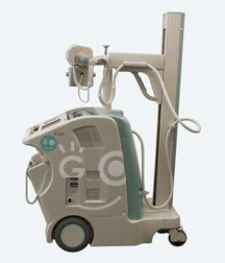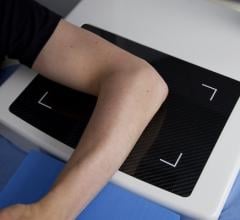
The FCR Go portable digital X-ray system by FUJIFILM Medical adds to the flexibility of CR use.
The conversion of a radiology department from film to digital, accompanied by the adoption of a new PACS, often sparks the debate over whether to purchase a computed radiography system (CR) or digital radiography system (DR). For many medical facilities, CR is more appealing in large part due to its portability and lower ticket price compared to DR. Plus, purchasing a CR eliminates the cost of renovating the X-ray room or retrofitting the equipment. However, the argument in favor of DR technology — that it facilitates higher patient throughput and provides better image quality — is causing many hospitals to consider purchasing a DR system for the emergency room (ER). While CR continues to dominate the general radiography market, recent technical advances in DR technology promise to give CR a run for its money. CR is Slick Many hospitals initially converted from film screen to CR because it is cheaper than DR and they can simply retrofit their old X-ray equipment using CR cassettes. “CR is very slick. The cassette is key,” noted Todd Minnigh, worldwide director of marketing, digital radiography, Carestream Health. And in an emergency department setting, cassettes are critical for providing flexibility, allowing clinicians to capture images in hard-to-reach angles. At Rush Health Systems, clinicians use the 350 and Xpress CR systems by Konica Minolta for every “plain X-ray exam, including chest X-rays, abdomen, hand and feet,” explained Jamie Feasel, the ER radiology manager. “We may need to shoot angles or go to the patient’s room when it is a serious trauma where the patient is too critical to go to our X-ray department. With the CR we can use our regular portable equipment that every hospital has and still have the benefits of the digital radiography,” said Feasel. “We have the 350 CR chest stand that is like a DR system and is really convenient when we have a lot of chest X-rays or a lot of abdomen X-rays and even for some ambulatory patients. It is really nice with the 350 chest X-ray to be able to do chest X-rays really quickly, and when you have 20 patients waiting to be done, every second counts.” More Portable and Affordable The big advantage of DR over CR has been improved productivity and higher image quality. However, these attributes are often outweighed by another consideration – cost. One of the biggest challenges of investing in a DR system is having the appropriate infrastructure to install it, or in many cases an existing room has to be renovated to accommodate a new system. Manufacturers have tried to work around these obstacles by developing portable DR systems. A portable DR would not require stripping out existing film or CR rooms. However, if CR scanners are getting smaller, less-expensive and more portable, then how would portable DR have an advantage, both clinically and economically, over the portable CR? This is the question Charles E. Willis, Ph.D., DABR, University of Texas M.D. Anderson Cancer Center, Houston, asks in the study “Clinical Utility of CR and DR in the ER.” Willis concludes that “digital bedside radiography promises to improve imaging for the sickest patients,” however he points out that the one problem with DR is still cost. Cutting costs in DR installations is a key area of focus for manufacturers. Carestream Health is currently launching the new Carestream DRX-1 System, a wireless DR detector that is the size of a standard cassette and can be used with existing wall stand or table-based buckys. What makes this system unique is the DR panels are the same size as CR plates being used at the moment - just pull the CR plate out and plug in the Carestream flat panel. This means the DR system is a direct replacement; no retrofitting and no modifications to existing analog equipment are required. Therefore, radiology rooms don’t need to retrofit or replace all their imaging equipment to go digital. New lightweight designs are also contributing to the new era of portable DR systems. Canon U.S.A. recently came out with a portable digital radiography (DR) system, the Canon CXDI-60G Portable Flat Panel Detector, which includes room-to-room installations and mobile X-ray systems. The lightweight detector has a detachable sensor cable designed to enable easy room-to-room installation from multiple locations to treat trauma patient’s bedside or in a wheelchair. The detector, which weighs 5.9 pounds and is less than an inch thick, offers an effective imaging area of 9 x 11 inches, enabling clinicians to X-ray hands, elbows, feet and knees, among the most common orthopedic examinations. An optional preview monitor allows X-ray images to be confirmed approximately three seconds after exposure. Whether it is an adjustable cord for room-to-room installations or wireless, these recent introductions attest to the fact that DR is moving toward portability. CR Moves into Mammo Before DR takes too big of a bite out of the market, CR has another feature up its sleeve - digital mammography. Factors driving the move toward CR mammography is cost-effectiveness, the ability to retrofit a unit and flexibility. In addition, CR can provide a smoother transition into digital mammography for many facilities seeking to take the first step into the digital territory. Fuji now offers an FDA-cleared CR used with a mammography component called the FCRm. Also, Health Canada recently approved Carestream Health’s mammography feature offered with its new KODAK DIRECTVIEW Classic and Elite CR systems, allowing Canadian healthcare facilities to perform mammography exams with these CR systems. Plus, there are more models on the way. The advantage of CR for mammography (CRm) is that it may speed the transition to digital mammography because it doesn’t necessarily require an investment in an entirely new system as it can be used with existing equipment. Plus, it allows digital storage and image manipulation. For many outpatient centers seeking to attract more patients and more revenue, offering digital mammography is an alluring extension to their service portfolios. “Hospitals and women’s imaging facilities that are in the business of women’s imaging have a strong incentive to provide FFDM. Reimbursements and now even patient awareness are driving this need. The choice between detector technology used in the FFDM modality should be driven based on image quality and overall workflow of the environment,” said Robert E. Cooke, executive director of marketing, network systems, FujiFilm Medical Systems USA. “The entire care cycle in women’s imaging, particularly in screening applications, requires very high-end-to-end throughput and strong image quality. Fuji’s FFDM modality, coupled with Synapse, offers this unique combination.” Cooke added, “As more detector technologies emerge on the market through down classification and/or other PMA approvals, we feel this will benefit the entire industry, and offer more choices to the facility and patients, and more opportunity for us to differentiate with our solution.” CR, however, has a few obstacles to overcome before it supplants the film for mammography. To begin with, the ACRIN study limited digital’s superiority to a smaller sub-class of female patients. As for the workflow, digital is reportedly equal to that of film and the effectiveness of computer-aided detection (CAD) systems as a second read is still under scrutiny. Facilities should also be aware that simply adding on another piece of equipment is not enough. A workflow redesign should complement the transition. To facilitate the adoption of CR for mammography, companies like Carestream Health offer a digitizer to convert film-based priors to a DICOM-based digital imaging format to compare with current digital images. Fuji and iCAD recently received 510(k) clearance for SecondLook Digital, a CAD solution designed specifically for its Fuji’s CR for mammography system (FCRm). SecondLook Digital for FCRm is the first CAD product available in the U.S. for use with CR. Hologic offers the R2 DigitalNow solution to bridge to a digital environment, allowing mammography departments to digitize priors and archive to PACS for use in a soft-copy viewing environment. The industry is clearly betting on CR for mammography to become an appealing add-on for hospitals and outpatient centers. But the question remains — if CR for mammography does win the hearts of the end-users, will this fact add more fuel to the fire in the ongoing debate over purchasing a CR or a DR system for the ER? Whether CRm is the deciding factor is yet unclear.



 December 10, 2025
December 10, 2025 









